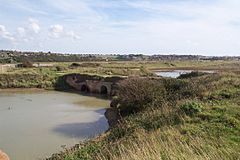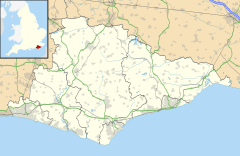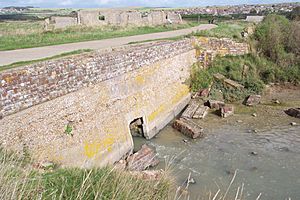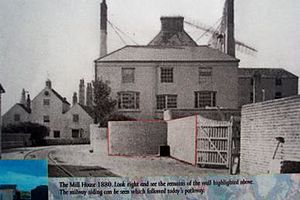Tide Mills, East Sussex facts for kids
Quick facts for kids Tide Mills |
|
|---|---|
 The derelict mill race sluice, from the seaward side |
|
| OS grid reference | TQ459002 |
| • London | 50 miles (80 km) N |
| Civil parish | |
| District |
|
| Shire county | |
| Region | |
| Country | England |
| Sovereign state | United Kingdom |
| Police | Sussex |
| Fire | East Sussex |
| Ambulance | South East Coast |
| EU Parliament | South East England |
| UK Parliament |
|
Tide Mills is an old, abandoned village in East Sussex, England. It is located about two kilometers (1.2 miles) south-east of Newhaven. It is also about four kilometers (2.5 miles) north-west of Seaford. The village is close to both Bishopstone and East Blatchington. The homes in Tide Mills were declared unsafe in 1936. The last people living there had to leave by 1939.
Contents
The Story of Tide Mills Village
The history of Tide Mills began with a powerful politician named Thomas Pelham. He was also a prime minister and held the title of Duke of Newcastle. Thomas Pelham owned land near Bishopstone. He got a special law passed by Parliament. This law allowed him to use the beach area for building a tide mill.
Building the Tide Mill
Construction of the mill started in 1761. However, Thomas Pelham died in 1768. The mill was not finished until 1788. Three years later, it was put up for sale. An advertisement in the Sussex Weekly Advertiser described it. The mill had five pairs of grinding stones. It could produce 130 quarters (about 1.65 tonnes) of wheat each week.
The mill's location by the sea often caused problems. In 1792, a strong storm hit the area. It destroyed a lot of flour and wheat at the mill.
New Owners and Improvements
Later, a man named Thomas Barton bought the mill site. He wanted to make the mill work better. He built a new, three-story mill building. This new building held 16 pairs of grinding stones. With these, he could make 1,500 sacks (about 190 tonnes) of flour every week.
Ownership of the mill changed hands several times. Different business partners came and went. William Catt (1770–1853) eventually took over. He came from a family involved in farming and milling. William Catt was a smart businessman. He managed the mill very well, and it became quite successful. Even so, storms still caused damage sometimes. For example, in 1820, a storm damaged the mill building. It also washed away part of the mill's dam.
Life in the Village
In 1851, a census showed that 60 men worked at the mill. Most of them lived in small houses nearby. William Catt had built these cottages for his workers. He also built a school for the children. Life there was simple, but a lively community grew. The workers were happy that their families had a place to live and learn. At that time, such things were not common.
A railway line was built from Newhaven to Seaford. A special track was added that ran near the cottages. This allowed large amounts of flour to be sent to Newhaven. From Newhaven, much of the flour was shipped to London by sea.
The Village Closes Down
The mill stopped working in 1883. It was then used as storage buildings until 1901, when it was taken down. The village itself was declared unsafe for living in 1936. The last people were forced to leave in 1939.
During the Second World War, the area was used by Canadian troops. Parts of the village were cleared to create open spaces. It was also used for training soldiers in street fighting.
Old Railway Station
There are still remains of an old railway station near Tide Mills. It was on the line between Newhaven and Seaford. This station was first called Bishopstone Station or Tide Mills Halt. Later, in 1939, it became Bishopstone Beach Halt. It closed in 1942. This old station is different from the Bishopstone railway station that exists today.
Mill Complex Features
Old pictures, paintings, and even a poem show something interesting. The Tide Mill complex also included a windmill. This means it used both the power of the tides and the wind to grind grain.
Visiting Tide Mills Today
You can get to Tide Mills in a couple of ways. One way is by a small, single-track road called Mill Drove. This road runs from the main Newhaven and Seaford roads. Parking is very limited there. You also have to cross the railway tracks at Bishopstone Beach Halt on foot.
Another way to get there is by walking along the beach. You can walk east from Newhaven Harbour. Network Rail plans to build a new footbridge over the railway tracks. This will replace the current crossing, making it safer to visit.
The Tide Mills Project
In 2020, a group called LYT Productions started a special project. It is a community arts and history project. Its goal is to explore the history of Tide Mills. This project gets money from several groups. These include the National Lottery Heritage Fund and the South Downs National Park Authority.
The project is researching the social history of Tide Mills. They want to share this history with more people. They are also creating online learning materials. In September 2021, they hosted a Heritage Celebration Week.
Images for kids







